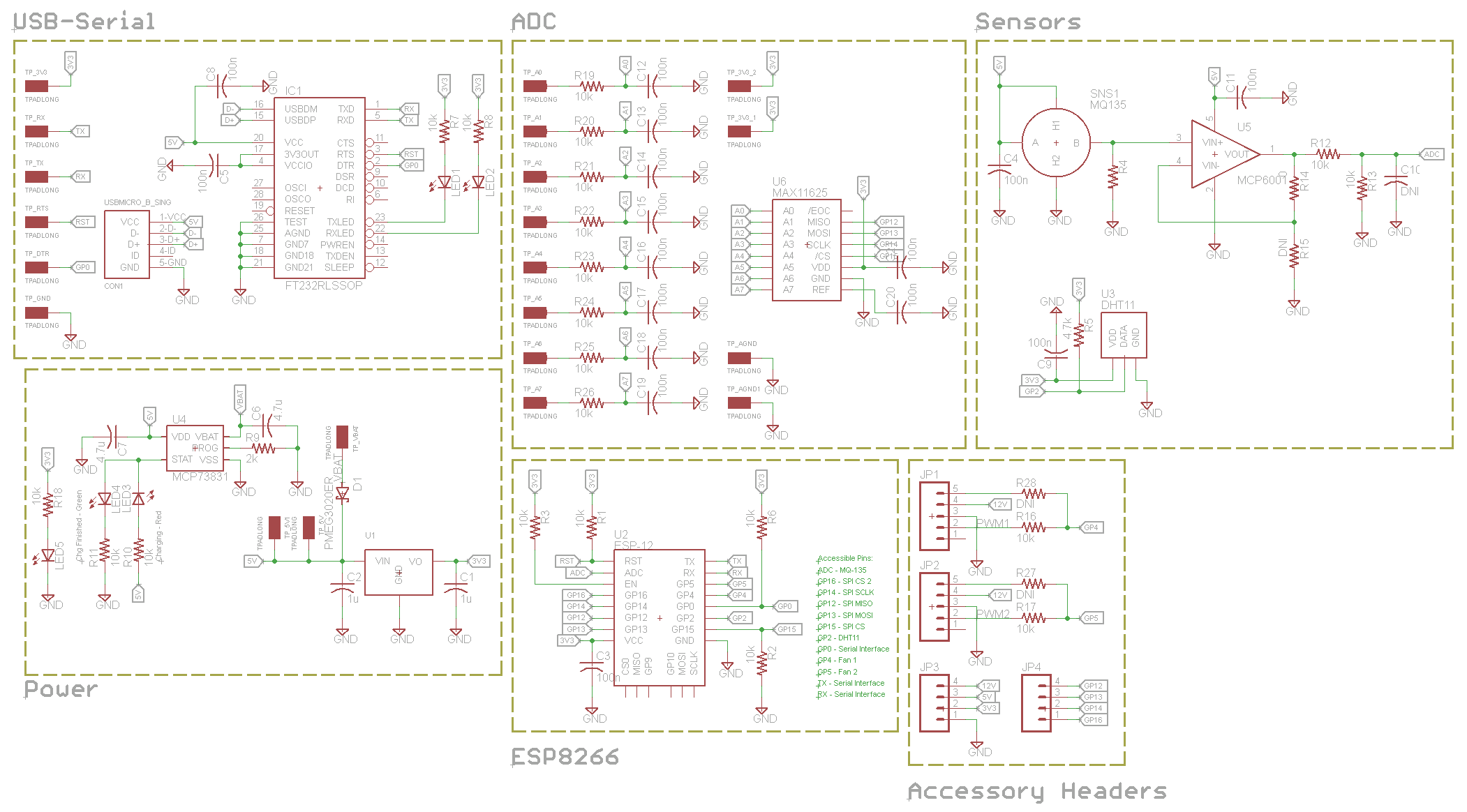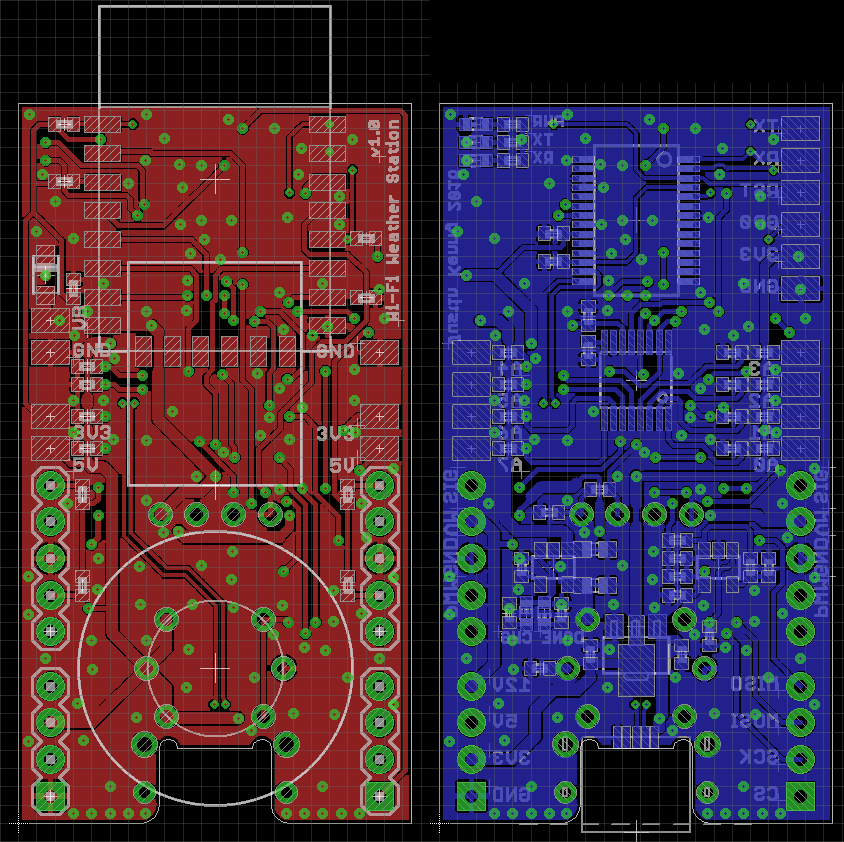ESP8266 DAQ: Difference between revisions
No edit summary |
|||
| (8 intermediate revisions by the same user not shown) | |||
| Line 1: | Line 1: | ||
This is a project to create a Wi-Fi enabled data collection unit supporting an 8-channel 12-bit ADC (MAX11629), DHT-11/22 temperature/humidity sensor, MQ-135 air quality sensor, | This is a project to create a Wi-Fi enabled data collection unit supporting an 8-channel 12-bit ADC (MAX11629), DHT-11/22 temperature/humidity sensor, MQ-135 air quality sensor, 2 CPU fan or servo outputs, SPI and UART interfaces, and is expandable to support a LiPo battery with on-board charging circuit. This project is based around an ESP-12E module, utilizing the ESP8266 Wi-Fi SOC which performs all Wi-Fi protocol processing and contains a general purpose MCU compatible with the Arduino IDE. | ||
[[File:ESP8266_DAQ | [[File:ESP8266_DAQ.jpg|thumb|right|ESP8266 DAQ with environmental sensors.]] | ||
==List of Features== | ==List of Features== | ||
* | * 802.11b/g/n Wi-Fi | ||
* | * 32-bit 80 MHz RISC CPU | ||
* | * 512kB(?) Flash for program/data storage | ||
* ~38kB Free SRAM | |||
* Uses Arduino IDE | |||
* On-board FT232RL for reprogramming and UART comms | |||
* micro USB connector for power/communication | |||
* 8 channel 12-bit ADC with RC input filter on each channel | |||
* Support for DHT-11/DHT-22 and MQ-135 for environmental sensing (temperature/humidity/air quality) | |||
* LED indicators | |||
* Support for LiPo battery with internal charging circuit | * Support for LiPo battery with internal charging circuit | ||
| Line 13: | Line 20: | ||
[[File:ESP8266_DAQ_Schematic.png|thumb|right|The complete system schematic for the ESP8266 DAQ.]] | [[File:ESP8266_DAQ_Schematic.png|thumb|right|The complete system schematic for the ESP8266 DAQ.]] | ||
[[File:ESP8266_DAQ_PCB.png|thumb|right|The PCB layout (top: red, bottom: blue) for the ESP8266 DAQ.]] | |||
This board contains the necessary circuitry to re-program the ESP8266 with the Arduino bootloader and program/debug through the Arduino IDE. The board also adds environmental sensing capability (temperature and humidity via the DHT-11 or DHT-22 sensor and air quality/CO2 via an MQ-135) and an 8-channel ADC. The GPIOs are mapped as follows: | |||
* '''TOUT (ADC)''' - MQ135 | |||
* '''TX''' - Serial Interface | |||
* '''RX''' - Serial Interface | |||
* '''GPIO0''' - Bootloader Dedicated | |||
* '''GPIO2''' - DHT-11/22 | |||
* '''GPIO4''' - Fan/Servo 1 | |||
* '''GPIO5''' - Fan/Servo 2 | |||
* '''GPIO12''' - SPI MISO | |||
* '''GPIO13''' - SPI MOSI | |||
* '''GPIO14''' - SPI SCLK | |||
* '''GPIO15''' - SPI CS (ADC) | |||
* '''GPIO16''' - SPI CS2 (External SPI device) | |||
===Hardware Revisions=== | ===Hardware Revisions=== | ||
| Line 27: | Line 43: | ||
'''Outstanding Issues:''' | '''Outstanding Issues:''' | ||
* | * None yet! | ||
====PCB Files==== | ====PCB Files==== | ||
Here is the Eagle schematic file for the ESP8266 DAQ: http://rev0.net/files/wifi_ws_v10.sch | Here is the Eagle schematic file for the ESP8266 DAQ: http://rev0.net/files/wifi_ws_v10.sch | ||
Here is the Eagle board file for the ESP8266 DAQ: http://rev0.net/files/wifi_ws_v10.brd | Here is the Eagle board file for the ESP8266 DAQ: http://rev0.net/files/wifi_ws_v10.brd | ||
| Line 41: | Line 58: | ||
==Code== | ==Code== | ||
Basic project template for connecting to Wi-Fi access point (SSID and WPA2 key hard-coded) and posting temperature/humidity + single ADC channel to a Thingspeak channel: http://rev0proto.com/files/ESP8266_DAQ.ino | |||
==Photos== | ==Photos== | ||
| Line 54: | Line 71: | ||
|Cost | |Cost | ||
|Source | |Source | ||
|- style="color: | |- style="color:navy;text-align:left;" | ||
|ESP-12E Module | |ESP-12E Module | ||
|$3.33 | |$3.33 | ||
|[http://www.ebay.com/itm/131497630292 eBay] | |[http://www.ebay.com/itm/131497630292 eBay] | ||
|- style="color: | |- style="color:green;text-align:left;" | ||
|PCB | |PCB | ||
|$1.40 | |$1.40 | ||
|[http://dirtypcbs.com/view.php?share=9435&accesskey=848559057f2751938392fce76a20d490 DirtyPCBs] | |[http://dirtypcbs.com/view.php?share=9435&accesskey=848559057f2751938392fce76a20d490 DirtyPCBs] | ||
|- style="color: | |- style="color:black;text-align:left;" | ||
|FT-232-RL | |FT-232-RL | ||
|$4.50 | |$4.50 | ||
|[http://www.mouser.com/Search/ProductDetail.aspx?R=FT232RL-REEL Mouser] | |[http://www.mouser.com/Search/ProductDetail.aspx?R=FT232RL-REEL Mouser] | ||
|- style=" | |- style="text-align:left;" | ||
|MAX11629 | |MAX11629 | ||
|$3.93 | |$3.93 | ||
|[http://www.mouser.com/Search/ProductDetail.aspx?R=MAX11629EEE Mouser] | |[http://www.mouser.com/Search/ProductDetail.aspx?R=MAX11629EEE Mouser] | ||
|- style=" | |- style="text-align:left;" | ||
|AP1117 | |AP1117 | ||
|$0. | |$0.28 | ||
|[http://www.mouser.com/Search/ProductDetail.aspx?R=AP1117IE33G-13 Mouser] | |[http://www.mouser.com/Search/ProductDetail.aspx?R=AP1117IE33G-13 Mouser] | ||
|- style=" | |- style="text-align:left;" | ||
|Passives/Misc. Components | |Passives/Misc. Components | ||
|$0. | |$0.50 | ||
|[http://www.digikey.com/ Digi-Key] | |[http://www.digikey.com/ Digi-Key] | ||
|- style="color:red;text-align:left;" | |- style="color:red;text-align:left;" | ||
|Total Price | |Total Price | ||
|~$13. | |~$13.94 | ||
| | | | ||
|- | |- | ||
|} | |} | ||
Latest revision as of 00:46, 21 August 2015
This is a project to create a Wi-Fi enabled data collection unit supporting an 8-channel 12-bit ADC (MAX11629), DHT-11/22 temperature/humidity sensor, MQ-135 air quality sensor, 2 CPU fan or servo outputs, SPI and UART interfaces, and is expandable to support a LiPo battery with on-board charging circuit. This project is based around an ESP-12E module, utilizing the ESP8266 Wi-Fi SOC which performs all Wi-Fi protocol processing and contains a general purpose MCU compatible with the Arduino IDE.
List of Features
- 802.11b/g/n Wi-Fi
- 32-bit 80 MHz RISC CPU
- 512kB(?) Flash for program/data storage
- ~38kB Free SRAM
- Uses Arduino IDE
- On-board FT232RL for reprogramming and UART comms
- micro USB connector for power/communication
- 8 channel 12-bit ADC with RC input filter on each channel
- Support for DHT-11/DHT-22 and MQ-135 for environmental sensing (temperature/humidity/air quality)
- LED indicators
- Support for LiPo battery with internal charging circuit
Electronics
This board contains the necessary circuitry to re-program the ESP8266 with the Arduino bootloader and program/debug through the Arduino IDE. The board also adds environmental sensing capability (temperature and humidity via the DHT-11 or DHT-22 sensor and air quality/CO2 via an MQ-135) and an 8-channel ADC. The GPIOs are mapped as follows:
- TOUT (ADC) - MQ135
- TX - Serial Interface
- RX - Serial Interface
- GPIO0 - Bootloader Dedicated
- GPIO2 - DHT-11/22
- GPIO4 - Fan/Servo 1
- GPIO5 - Fan/Servo 2
- GPIO12 - SPI MISO
- GPIO13 - SPI MOSI
- GPIO14 - SPI SCLK
- GPIO15 - SPI CS (ADC)
- GPIO16 - SPI CS2 (External SPI device)
Hardware Revisions
Revision 1.0
This is the first revision of the ESP8266 DAQ.
Outstanding Issues:
- None yet!
PCB Files
Here is the Eagle schematic file for the ESP8266 DAQ: http://rev0.net/files/wifi_ws_v10.sch
Here is the Eagle board file for the ESP8266 DAQ: http://rev0.net/files/wifi_ws_v10.brd
Enclosure
The enclosure for the ESP8266 DAQ was created with Autodesk Inventor 3D CAD software, and is 3D printed (in this case using a Makerbot Replicator 2). The enclosure is made of 2 separate pieces, which are assembled by snapping them together.
Here are the Autodesk Inventor files for the enclosure: http://rev0proto.com/files/ESP8266_Enclosure.zip
Code
Basic project template for connecting to Wi-Fi access point (SSID and WPA2 key hard-coded) and posting temperature/humidity + single ADC channel to a Thingspeak channel: http://rev0proto.com/files/ESP8266_DAQ.ino
Photos
- ESP8266 DAQ Top.jpg
...
Total Project Cost
| Component | Cost | Source |
| ESP-12E Module | $3.33 | eBay |
| PCB | $1.40 | DirtyPCBs |
| FT-232-RL | $4.50 | Mouser |
| MAX11629 | $3.93 | Mouser |
| AP1117 | $0.28 | Mouser |
| Passives/Misc. Components | $0.50 | Digi-Key |
| Total Price | ~$13.94 |

